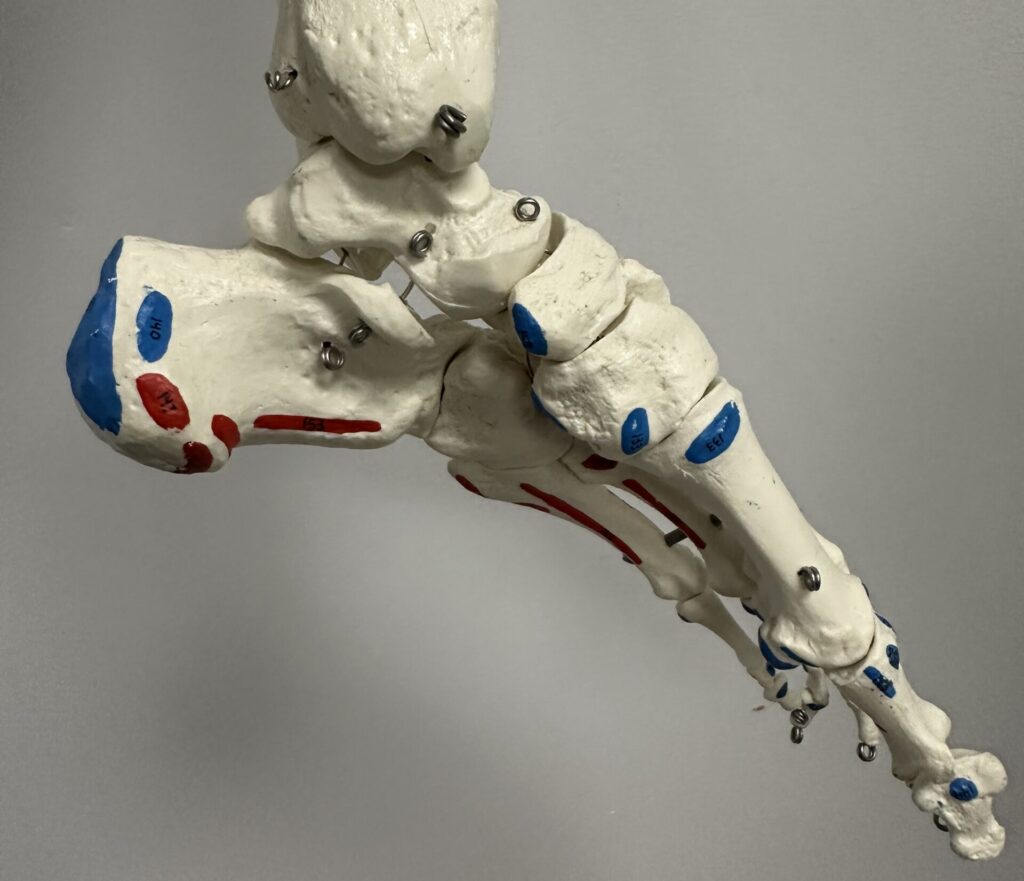Tarsal tunnel syndrome occurs when the tibial nerve is compressed near the ankle, causing pain and numbness in the foot. This article dives into the main symptoms, underlying causes, risk factors, and both conservative and surgical treatment options for managing tarsal tunnel syndrome.
Key Takeaways
Tarsal tunnel syndrome (TTS) is a nerve compression condition occurring around the medial ankle, primarily affecting the tibial nerve and often associated with both traumatic and idiopathic causes.
Symptoms of TTS include foot pain, tingling, and a burning sensation that worsen with activity; early identification and diagnosis are crucial for effective management.
Treatment options for TTS range from conservative approaches like physical therapy and orthotics to surgical intervention for severe cases, with a significant percentage experiencing symptom relief post-surgery.
Understanding Tarsal Tunnel Syndrome
Tarsal tunnel syndrome (TTS) is a rare condition. It involves compression of the tibial nerve, especially around the medial ankle. Similar to carpal tunnel syndrome in the wrist, TTS involves the compression of a nerve within a confined space, leading to pain and dysfunction. The tibial nerve, or more specifically, its posterior branch, is the primary culprit in this condition, which can also be referred to as posterior tarsal tunnel syndrome.
Active individuals, including both adults and children, are most commonly affected by TTS. Interestingly, the incidence is higher in females and can occur at any age. Recognizing TTS as an entrapment neuropathy aids in identifying symptoms and exploring effective treatment strategies.
Anatomy of the Tarsal Tunnel
The tarsal tunnel is a narrow space located posterior to the medial malleolus of the ankle, beneath the flexor retinaculum. This anatomical region is bordered medially by the flexor retinaculum, laterally by the posterior aspects of the talus and calcaneus, and anteriorly by the medial malleolus. The intricate structure of the tarsal tunnel includes several key components: the tibialis posterior tendon, flexor digitorum longus tendon, posterior tibial artery, posterior tibial nerve, and flexor hallucis longus tendon.
The tibial nerve originates from the ventral branches of the lumbar and sacral nerves, traveling alongside the posterior tibial vessels before entering the tarsal tunnel. Within the tunnel, the tibial nerve branches into the medial and lateral plantar nerves, which play crucial roles in foot sensation and movement. Additionally, posterior tibial nerve neuralgia can occur due to compression within the tarsal tunnel.
Causes and Risk Factors
Tarsal tunnel syndrome often arises from the entrapment or compression of the tibial nerve, frequently linked to post-traumatic injuries such as ankle sprains. However, not all cases have a clear origin; 20-40% are classified as idiopathic, meaning no specific cause is identified, including cases of developing tarsal tunnel syndrome.
Systemic diseases like diabetes, hypothyroidism, gout, and hyperlipidemia can increase the risk of developing TTS. Additionally, biomechanical factors such as severely flat feet and poorly fitting shoes can exacerbate the condition, particularly in individuals with flat foot. Recognizing these risk factors is crucial for prevention and early intervention.
Symptoms and Clinical Presentation
Common symptoms of tarsal tunnel syndrome include foot pain radiating to the plantar surface, tingling, and a burning sensation. These tarsal tunnel syndrome symptoms typically worsen with prolonged standing, walking, or starting a new exercise program, and can improve with rest. Chronic cases may reveal intrinsic muscle weakness and atrophy during physical examinations, alongside pain that radiates over the tarsal tunnel.
Identifying these symptoms early is key to effective management. Individuals experiencing persistent foot and ankle pain and tingling should consult a healthcare professional to rule out TTS and begin appropriate treatment.
Diagnosing Tarsal Tunnel Syndrome
Diagnosing tarsal tunnel syndrome can be challenging due to its rarity and symptom overlap with other conditions. A thorough clinical evaluation, including medical history and physical examination, is crucial. Physical examination techniques include tapping on the nerve (Tinel test) and pressing on the affected area to reproduce symptoms.
Imaging studies, especially MRI, are vital for identifying compression and underlying lesions. MRI serves as the gold standard with around 83% accuracy in detecting space-occupying lesions. If initial treatments do not yield symptom relief, advanced imaging studies and nerve conduction studies are warranted.
Electromyography (EMG) is critical for diagnosis, often revealing abnormalities, particularly in sensory studies. A positive Tinel test shows pain or tingling in the posterior tibial distribution. This finding predicts surgical relief following decompression. The dorsiflexion-eversion test is also commonly positive in patients with tarsal tunnel syndrome, confirming potential nerve compression.
Differential Diagnosis
Differentiating TTS from other conditions is crucial, as several ailments can mimic its symptoms. These include Achilles tendonitis, calcaneal spurs, foot arthroses, and plantar fasciitis. Compartment syndrome, which arises from excessive pressure in a muscle compartment, can also present similar symptoms.
Polyneuropathy, causing numbness and tingling in the foot, and deep flexor compartment syndrome must also be considered. Prompt diagnosis and differentiation are key for effective treatment and management.
Conservative Treatment Options
Various conservative treatments can alleviate TTS symptoms. These methods include pharmacological treatments, physical therapy, and the use of orthotics or braces.
Pharmacological Treatments
Pharmacological treatments such as nonsteroidal anti inflammatory drugs and steroid injections are significant for managing pain and inflammation in TTS. NSAIDs are commonly prescribed for alleviating pain in TTS.
Steroid injections are an effective option for reducing inflammation and providing pain relief. Combining NSAIDs and steroid injections can improve symptom management in TTS patients.
Physical Therapy
Physical therapy typically involves stretching techniques and improving nerve mobility. Exercises to enhance ankle flexibility and strength can significantly alleviate TTS symptoms.
Gentle calf stretches reduce muscle tightness around the ankle, relieving stress and swelling. Ankle rotations are crucial for maintaining flexibility and range of motion during recovery from tarsal tunnel syndrome.
Orthotics and Braces
Orthotic devices are essential for treating TTS by correcting biomechanical abnormalities and reducing pressure on the tarsal tunnel. Specialized arch supports can help redistribute pressure across the foot and lessen strain on the tarsal tunnel.
Surgical Intervention
Surgery is indicated for patients with tarsal tunnel syndrome who do not respond to conservative treatments and whose daily life is significantly affected. The procedure typically involves making a bow-shaped incision to decompress the posterior tibial nerve to treat tarsal tunnel syndrome.
Surgical outcomes vary, with success rates ranging from 44% to 96%. Approximately 85% to 90% of cases see an improvement or resolution of symptoms after surgical release. However, if left untreated, TTS may lead to permanent and irreversible nerve damage.
Postoperative Care and Rehabilitation
Postoperative rehabilitation aims to protect joint and nerve integrity while managing inflammation, pain, and swelling. The long-term goals involve achieving a normal gait. Long-term goals also include the ability to walk and run effectively.
Post-surgery, the affected limb should be elevated and remain non-weight bearing for at least two weeks. Complete recovery can span from three to six months, influenced by the individual’s specific recovery progress.
Preventing Tarsal Tunnel Syndrome
Preventing tarsal tunnel syndrome involves selecting shoes that offer adequate arch support and cushioning; avoiding tight-fitting footwear that might compress the tibial nerve. Wider shoes with proper arch supports can significantly ease the discomfort caused by TTS.
Additionally, addressing factors like trauma, anatomical abnormalities, and systemic inflammatory conditions can prevent the exacerbation of TTS symptoms.
Prognosis and Long-Term Management
The prognosis for TTS patients is guarded, with frequent occurrences of relapse and remission. Early treatment increases the chances of effectively managing symptoms and possibly curing the condition. If left untreated, TTS can lead to irreversible nerve damage and difficulty in daily activities.
Long-term management includes maintaining a healthy weight, engaging in low-impact exercises like swimming or cycling, and practicing proper posture. Ergonomically adjusting your workspace can reduce foot strain during prolonged standing or sitting.
Summary
Tarsal tunnel syndrome, though less common than its carpal counterpart, can significantly impact an individual’s quality of life. Recognizing the symptoms early, understanding the causes and risk factors, and exploring both conservative and surgical treatments are essential steps in managing TTS.
By adopting preventive measures, seeking early diagnosis, and following appropriate treatment plans, individuals can effectively manage and even overcome the challenges posed by TTS. Proactive management and a comprehensive understanding of the condition are key to a better quality of life.
Frequently Asked Questions
What are the primary symptoms of tarsal tunnel syndrome?
The primary symptoms of tarsal tunnel syndrome include foot pain radiating to the plantar surface, tingling, burning sensations, and muscle weakness, all of which tend to worsen with prolonged standing or walking. It is important to address these symptoms promptly to avoid further discomfort.
How is tarsal tunnel syndrome diagnosed?
Tarsal tunnel syndrome is diagnosed through a thorough clinical evaluation and physical examination including the Tinel test, alongside imaging studies like MRI and nerve conduction velocity assessments. This multifaceted approach ensures accurate identification of the condition.
What are the conservative treatment options for tarsal tunnel syndrome?
Conservative treatment options for tarsal tunnel syndrome encompass the use of NSAIDs and steroid injections, paired with physical therapy and the application of orthotics or braces to relieve symptoms. These measures aim to reduce inflammation and support the affected area effectively.
When is surgery considered for tarsal tunnel syndrome?
Surgery for tarsal tunnel syndrome is considered when conservative treatments fail and daily activities are significantly impacted. The surgical procedure generally aims to decompress the posterior tibial nerve.
How can tarsal tunnel syndrome be prevented?
To prevent tarsal tunnel syndrome, it is essential to wear shoes with proper arch support and avoid tight-fitting footwear. Additionally, addressing underlying factors such as trauma and systemic inflammatory conditions can further reduce the risk of developing this syndrome.

